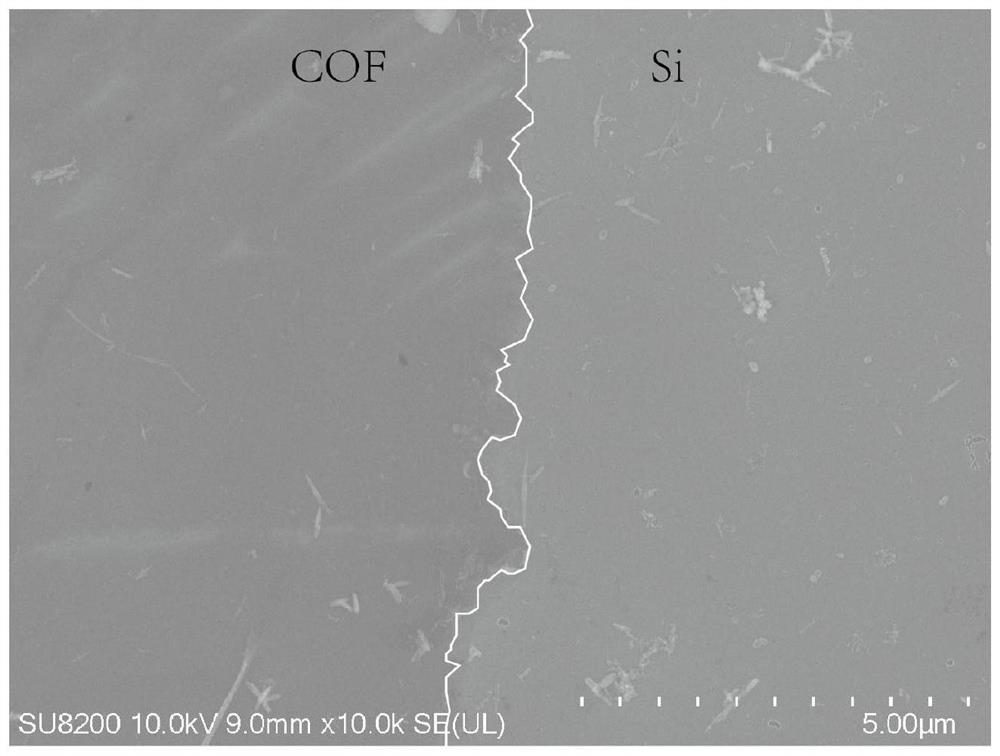Silicon-based covalent organic framework photoelectrode and preparation method and application thereof
A covalent organic framework and photoelectrode technology, which is applied in chemical instruments and methods, physical/chemical process catalysts, catalyst regeneration/reactivation, etc., can solve the problem of photocatalyst and electronic mediator loss, limited improvement of regeneration efficiency, The number of electrons is small, etc., to achieve the effect of improving electron transfer efficiency, preventing corrosion, and being easy to obtain
- Summary
- Abstract
- Description
- Claims
- Application Information
AI Technical Summary
Problems solved by technology
Method used
Image
Examples
Embodiment 1
[0075] This embodiment provides a preparation method of a silicon-based covalent organic framework photoelectrode, and the preparation method includes the following steps:
[0076] (1) Prepare the silicon substrate used in the electrode, cut the P-type silicon to a size of 1 cm×1 cm, and use acetone, isopropanol and ethanol for ultrasonic cleaning in sequence;
[0077] (2) prepare a metal foil with graphene, and spin-coat a layer of polymethyl methacrylate support layer on the graphene, then use a mixed aqueous solution of copper sulfate and hydrochloric acid as an etching solution to remove the metal foil to obtain graphene / polymethyl methacrylate film, after the graphene / polymethyl methacrylate film is washed multiple times and then transferred to a silicon substrate, after drying, soaked in remover acetone to remove polymethyl methacrylate, Finally, use isopropanol and / or water to clean, and use nitrogen to dry, form an electron conduction layer, and obtain a first compos...
Embodiment 2
[0081] This embodiment provides a method for preparing a silicon-based covalent organic framework photoelectrode, except that in step (3), 0.6 mg of 5,10,15,20-tetrakis(4-aminophenyl) is dissolved by ultrasonic waves Porphyrin and 0.3 mg of 2,2'-bipyridine-5,5'-dicarbaldehyde were subjected to a solvothermal reaction at 140°C for 2 days and stirring for 4h in step (4), other conditions and Example 1 Exactly the same.
Embodiment 3
[0083] This embodiment provides a method for preparing a silicon-based covalent organic skeleton photoelectrode. In the method, in addition to using a mixed solvent consisting of 1 mL of tetrahydrofuran, 7 mL of ethanol and 1 mL of acetic acid to dissolve 0.45 mg of 5, 10, 15 , 20-tetrakis(4-aminophenyl)porphyrin and 0.3 mg of 2,2'-bipyridine-5,5'-dicarbaldehyde in a solvothermal reaction at 160°C for 1 day and step (4) The other conditions were exactly the same as in Example 1, except that the mixture was stirred for 8 h.
PUM
| Property | Measurement | Unit |
|---|---|---|
| thickness | aaaaa | aaaaa |
| thickness | aaaaa | aaaaa |
Abstract
Description
Claims
Application Information
 Login to View More
Login to View More - R&D
- Intellectual Property
- Life Sciences
- Materials
- Tech Scout
- Unparalleled Data Quality
- Higher Quality Content
- 60% Fewer Hallucinations
Browse by: Latest US Patents, China's latest patents, Technical Efficacy Thesaurus, Application Domain, Technology Topic, Popular Technical Reports.
© 2025 PatSnap. All rights reserved.Legal|Privacy policy|Modern Slavery Act Transparency Statement|Sitemap|About US| Contact US: help@patsnap.com



